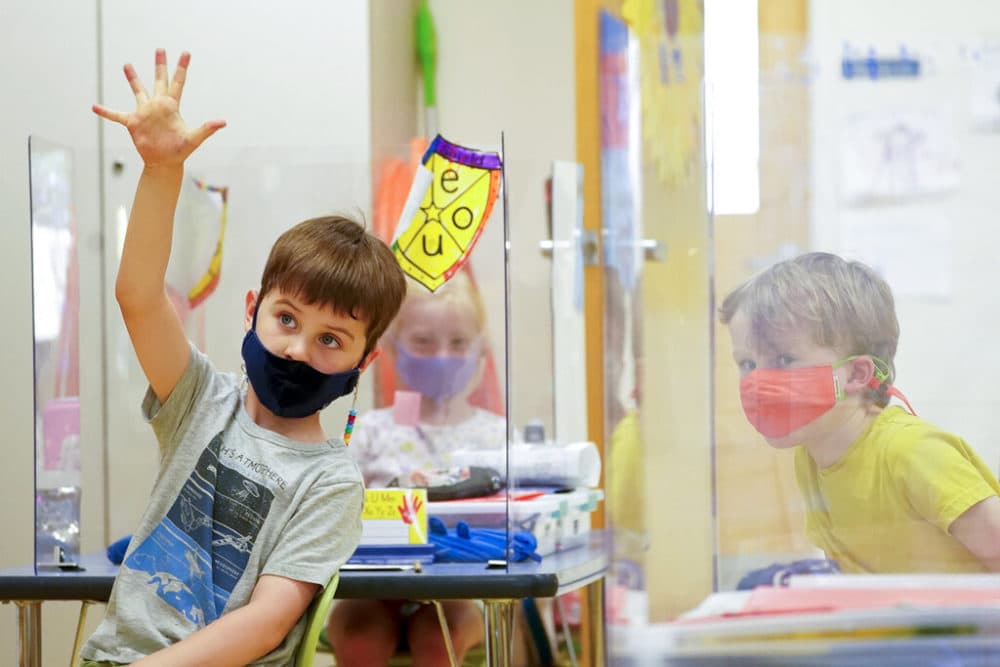Advertisement
On Point's Coronavirus Hours
Inside The Push To Get Students Back To School

Education Secretary Miguel Cardona wants ‘back to school’ to mean just that. But are parents and teachers on board? Cardona joins us for a conversation on the push to get students back in classrooms.
Guests
Sec. Miguel Cardona, U.S. Secretary of Education. (@SecCardona)
Janelle Scott, professor in the graduate school of education and African American studies department at the University of California, Berkeley. Distinguished chair in educational disparities. (@janelletscott)
Mike Waldrip, superintendent of the Frisco Independent School District in Texas. (@waldripm)
Also Featured
Heather Roell, mother of two elementary school students in the Austin Independent School District in Texas. (@hroell)
Sharnissa Secrett, clinical social worker and mother of six in Portland, Oregon.
Interview Highlights with Sec. Miguel Cardona
What's your expectation for the fall, in terms of returning to in-person instruction?
Miguel Cardona: "I expect all students to have an opportunity to be in school every day in the fall. And I expect that the school system that they return to is going to be better than it was prior to the pandemic. So those are some of the expectations that I have. The bar of March 2020 is too low. Our students are coming back with greater need, and I want to make sure that our school system across the country is there to meet their needs."
What percentage of schools across the country have already returned to in-person learning, and what percentage are offering a mix of remote learning and in-person learning?
Miguel Cardona: "The data systems used to collect these that we have are being developed. You know, we have some March data. I think next week we're going to get updated data. And so the data that I'm going to share with you right now is a month and a half old. But we know that about 90% of our students are being offered in-person learning opportunities. Over half are full-time in person.
"Again, that was late March. So I know that the numbers are much better now. But as you said earlier, it's uneven. There are some groups of students who are coming in at a less percentage. And that's part of the work that we're going to have as educators to make sure that all students are accessing in-person learning, and that some of those fears are addressed."
Some families in low income and communities of color, who were hit very hard by COVID-19, have concerns about sending their kids back into the classroom. How do we address those fears?
Miguel Cardona: "I remember a year ago, this time of year, looking at the data. I was commissioner in Connecticut, looking at the data and seeing that in more densely populated communities, or in communities where there were more people of color, communities of color, there was a greater mortality rate, the transmission rate was higher. So it's understandable that there's fear. It's understandable that there's some hesitation still. Keeping in mind that many of these communities lost loved ones more than other communities. That they're dealing with the trauma of the pandemic in different ways.
"So I think we have to recognize that. And to address that, some of the strategies, as you asked. I was in Boston recently and I saw that they put vaccination clinics in the communities, in those same communities. And members of the community with social capital, people that were trusted in the community, the pastors, the teachers, the school leaders were the ones communicating with families about the efficacy of vaccines, of the safety of it. Were modeling how they're getting it, and that they're getting it for their families.
"So that there's a sense of trust that they're going to be OK, and that the vaccines are going to help provide that level of safety that we need in our schools and in our communities. So having messaging done by the people in these communities that are trusted and well known in those communities matters. And ensuring that we're going to them. That if we're doing vaccine clinics, we're doing it in places that they're familiar with, it could be their schools, it could be their churches, it could be community centers. That's what I saw in Boston. They were doing vaccines in community centers. So those are some ways to increase the confidence."
Advertisement
How do you address the fears of parents sending kids under 12 back into schools?
Miguel Cardona: "We do know that vaccines are a tremendous tool, but it's not the only tool. We've seen success across the country of schools opening without transmission in their schools since August of this past year. So I can tell you, my children have been able to attend school since August of last year, and they were able to do it in a way that was safe. I would not compromise the safety of my children either. So we can show examples of it. We can communicate with families. We can continue to share that messaging, that the mitigation strategies work.
"And now that the transmission rates are where they are, we can continue to build confidence and slowly get them in. I would argue that we need to take advantage of the summer months to get these families comfortable sending their children to school, giving them opportunities to be with other students. We know there's no substitute for in-person learning. We know there's no substitute for that social interaction that our little ones need. So I think we have to continue to communicate. And make sure that when we're communicating, we're also allowing those folks who have good relationships in the community with these families to be a part of that messaging."
Will remote learning have a place in education moving forward?
Miguel Cardona: "I think instead of calling it remote learning, I'll call it blended learning. So some mix of in-person and remote learning is blended learning. And for years before the pandemic, many districts were working hard to try to give opportunities to students to learn remotely, because not all learning happens in the classroom. And we have to take advantage of the fact that learning can take place elsewhere. So I think this is going to accelerate that opportunity under innovative ideas. So I'd love to see innovation.
"I said earlier, we don't want to go back to a school system like what it was before the pandemic. We want to do better. And we learned that blended learning does provide opportunities for students that they wouldn't have if they had to report to a brick and mortar building every day. We know that you might have access to courses now because you can learn them online that you didn't have access to before, because maybe staffing needs, or limited enrollment in certain classes. So there's tremendous opportunity for remote learning to be a part of the landscape and education moving forward. I think it has to be done creatively and ensuring that we're giving students more opportunities."
Highlights edited for clarity.
From The Reading List
Chalkbeat: "‘I expect it.’ Cardona says every school needs in-person instruction this fall" — "Education Secretary Miguel Cardona said he expects every school to offer in-person instruction this fall — and that while there is a place for online learning, not every student requires a virtual learning option."
Wall Street Journal: "Some Schools Struggle to Get Students to Return After Months of Remote Learning" — "When doors swung open at District of Columbia Public Schools in February, teacher Landon Garvik’s fourth grade classroom sat empty. Not one student returned for in-person learning." — "
Associated Press: "Some Black parents say remote learning gives racism reprieve" — "Before schools shuttered during the pandemic, Ayaana Johnson worried every time she dropped her daughters off at school."
CBS DFW: "Texas School Districts, Parents Hoping Full Virtual Learning Remains An Option This Fall" — "While educators and parents agree most students need to learn in school, Frisco ISD administrators and parents want to offer a fully virtual curriculum for students this fall."
This program aired on May 27, 2021.

